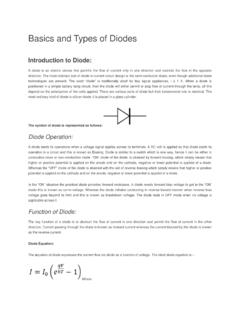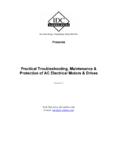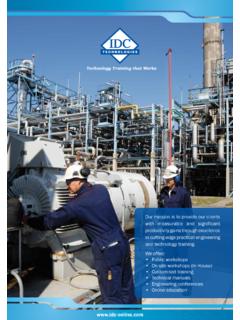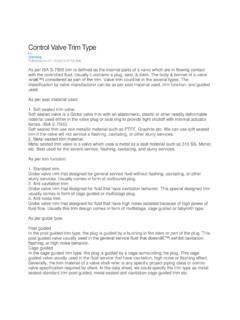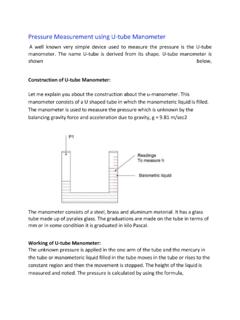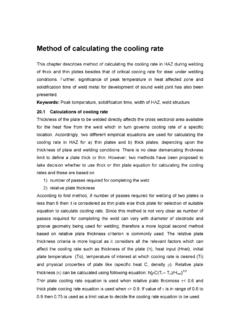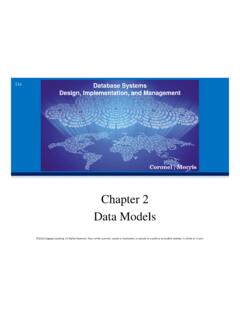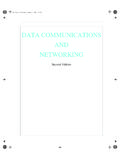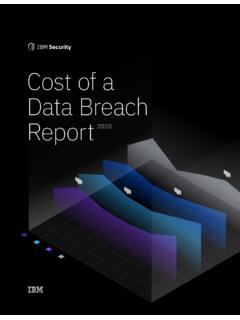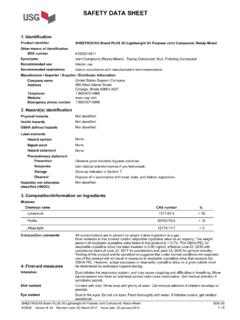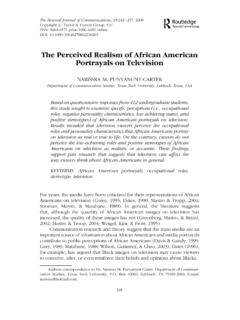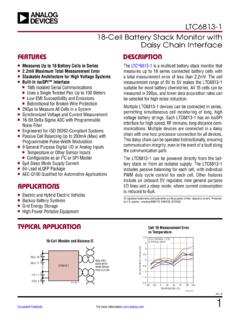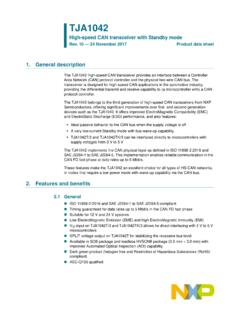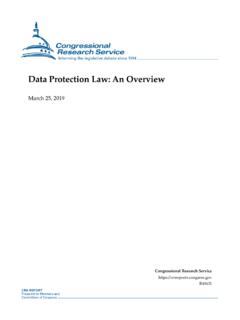Transcription of RG-58 Specifications
1 RG58. RG-58 is a coaxial cable that is used for wiring purposes. A coaxial cable, in general, consists of an inner conductor that is surrounded by a spacer. The coaxial cable is electrically charged and sometimes consists of different uninsulated conductors that remain entangled with one another. The insulating spacer of the cable is further surrounded by a sheath that is cylindrical in shape. The final circle is formed by an insulating jacket. The insulation surrounding the RG- 58 cable carries a low impedance of around 50 or 52 ohms. It is generally used for generating signal connections that are of low power. RG-58 Specifications Type RG-58 RG-58A RG-58B RG-58C. Impedance 52 50. Z0( ). Solid Solid Solid Solid Dielectric Polyethylene Polyethylene Polyethylene Polyethylene Time Delay (ns/ft). Propagation Velocity (% of c). Capacitance (pF/foot). Outside Dimensions (inches). dB/100ft 14 14. @400 MHz Maximum 1900 1900 1900 1900. Voltage (Vrms). Shield Braid Braid Braid Braid The RG-58 cable is most often used for the Thin Ethernet when the maximum length required is about 185 meters.
2 The RG-58 cable frequently acts as a generic carrier of power signals. These signals are generated in physical laboratories. The RG-58 cable is at times collectively used with BNC connectors that are commonly found in oscilloscopes. The BNC connector is in fact the common connector for the RG-58 cable. The BNCconnector is used for terminating the coaxial cable in the RG- 58. This particular connector provides signals for radio antenna connections, electronics used for aviation, and for conducting video signals. When the RG-58 . cable combines with the BNC connector, it can produce composite video played on commercial video devices. The interconnection between the RG-58 cable and the BNC connector can lead to ground loops when these are further connected with several coaxial cables. The combinations might produce an unwanted flow of current in a conductor that joins two points at similar potential. This interconnection is capable of pulling around 50 to 60 Hz fields from the AC mains.
3 The RG-58 cable is specially designed to work with most two-way radio systems. This communication system is different from the usual broadcast receiver because the latter can receive data from one end only. In case of the two-way radio system, which can be generated by the RG-58 cable, content travels in both directions. The radio can receive and transmit data at the same time. It is also called a transceiver. The transmitter is activated by means of a push-to-talk button. These radio systems work with the 50-ohm RG-58 cable. Examples of such radio systems are marine SSB, police transmitters, fire, WLAN antennas, and marine VHF. The RG-58 can also be used for higher frequencies. The range, however, remains fairly moderate. The coaxial cable that is used for generating the power signals is usually a quarter-inch in diameter. The Ethernet wiring for which the RG-58 cable is used is sometimes termed cheapernet , since it draws low-power signal connections. There are several well-known manufacturers that have excelled in the field of manufacturing high-quality RG-58 cables for wiring.
4 The RG-58 cables are used for both domestic and industry purposes. They are highly advanced in telecommunications, which is primarily generated by means of the coaxial cable and the BNC connector. Related Reading on RG-58 . RG58 is a classification of coaxial cable that is used for RF (Radio Frequency) communication systems. A coaxial cable is a multi-layered electrical cable that has an internal conductor which is enclosed by tubular insulation, which is in turn completely enclosed by a conductive cover and is finally sheltered with a thin insulating layer. RG58 has a distinct impedance of either 50 or 52 ohms. The RG58 cable is prominently used for two-way radio communication systems, such as amateur radio, police radio, marine VHF (Very High Frequency), WLAN. (Wireless Local Area Network) antennas and so on. It is also used along with BNC connectors to test laboratory equipment connections. The RG58 cable was formerly used with Thin Ethernet , as it was low-cost, flexible in form and easy to set up.
5 It was otherwise known as 10 Baseband2. (10B2). It was specifically used for baseband communications at 10 Mbps speed, maximum of attached nodded, and covering a maximum distance of 185. meters. Devices or computers connected to the network were wired in a bus topology. The network interface cards of the computers were connected to 10B2 cabling via a BNC T connector. The beginning and end of the bus were fixed to 50. Ohm terminators. Today, Cat5 and Cat5e cables have entirely replaced 10B2. cables. Disadvantages of using RG58 cabling in networking At first, RG58 cabling was ideal for setting up small workgroup based networks, as it was a low-cost option. However, as requirements and capacities increased it proved to be inadequate. The disadvantages of RG58 cabling are as follows: Complicated system the 10B2 network is bus based, hence any change will affect all the devices or computers on the network, which leads to downtime. Limited scope RG58 cabling supports a maximum of 30 nodes and maximum distance of 185.
6 Meters. Dedicated cable The RG58 cable used to setup 10B2 networks cannot be used for any other function. If the network is upgraded, the cables will have to be completely changed. Source.
